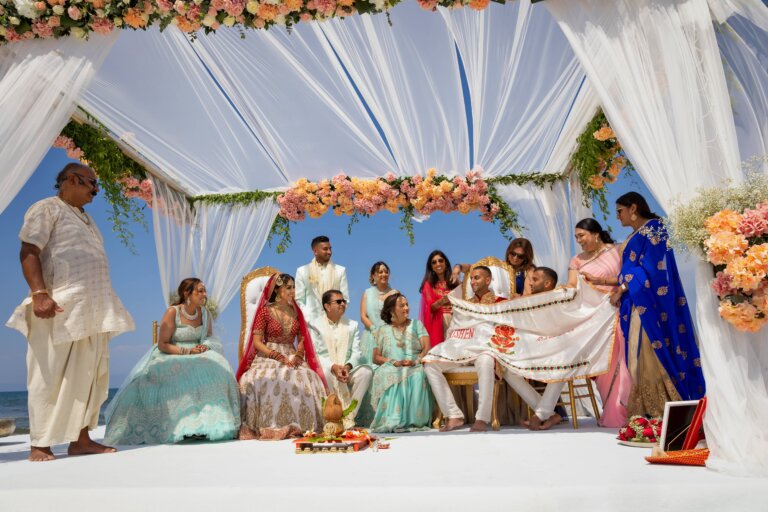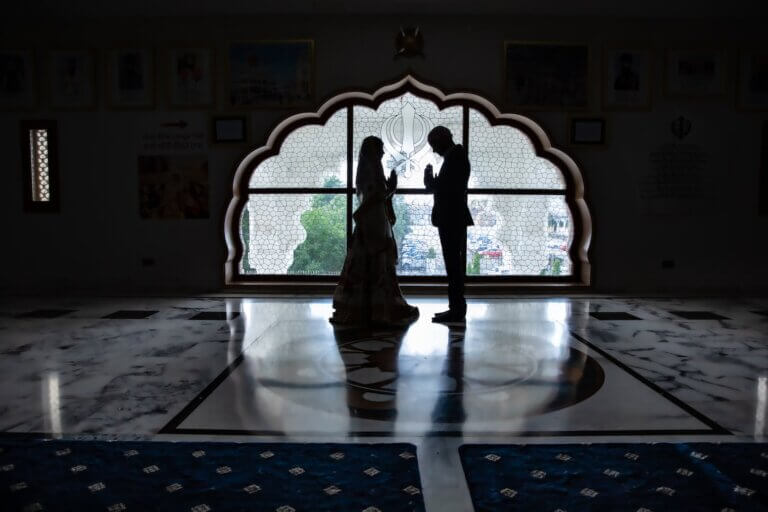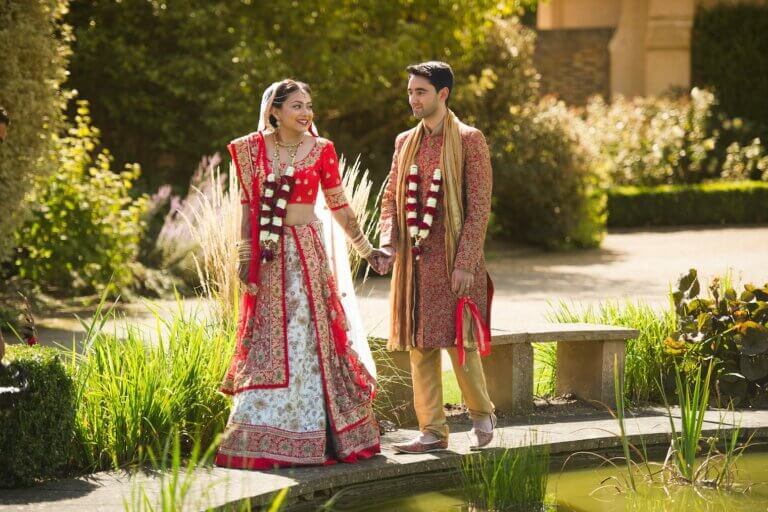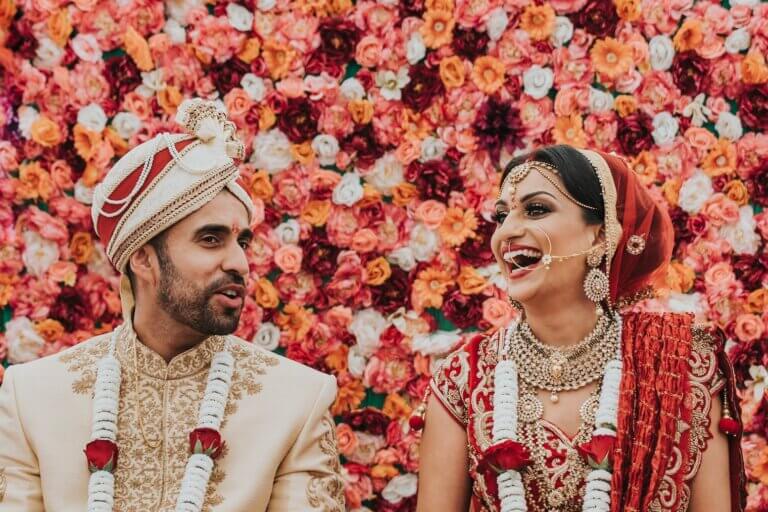There are few wedding ceremonies out there quite as vibrant, exciting and fun as a Hindu ceremony. They’re absolutely filled to the brim with traditions and rituals, with a heavy focus on celebrating the coming together of two people in love.
Many of the traditions are based on ancient scriptures so have been included in Hindu wedding ceremonies for hundreds of years. Every part of the ceremony has a symbolic meaning that is an important and must-have inclusion for every Hindu couple that gets married.
But, with so much incredible history, you no doubt have a lot of questions about what goes into a Hindu wedding ceremony. For example, how long is a Hindu ceremony? Is there a certain day or date you should get married on if you’re Hindu? Where can you hold your ceremony? What are some of the most popular traditions?
With so many different elements included in a Hindu ceremony, it’s only natural that you might have a few questions. That’s where we come in. In this guide, we’re going to dive into everything to do with Hindu wedding ceremonies, from the cost of the wedding to the order on the big day. That way, you’ll be as prepared as possible when planning your own ceremony.
For more information about the different types of wedding ceremonies, read our ultimate wedding ceremony guide.
What is a Hindu wedding ceremony?

A Hindu wedding ceremony is a joyous occasion when two people come together to get married, joined by their friends and family. Also known as a Vivaha or Kalyanam, a Hindu wedding ceremony can last up to three hours, but the celebrations begin several days early and can continue long after it’s done. Some Hindu weddings can last as long as five days (though usually last around three).
Hindu ceremonies are as long as they are because of the wonderful rituals and traditions that have deep and rich cultural meanings. Ceremonies can differ based on region, culture and other traditions, but every Hindu wedding you go to will generally have most of the same elements to them. The actual ceremony itself usually takes place on the final day of the celebrations.
What date should you have a Hindu wedding ceremony?

When choosing the perfect date for a Hindu wedding, you’ll probably want to turn astrological charts to find out the most auspicious dates for your big day. For example, a popular time for a wedding ceremony is after the new moon because it’s considered lucky. Similarly, you might want to look at your birth chart, as this can offer valuable insight into lucky dates.
However, you might also want to pay close attention to the day of the week. Monday, Wednesday, Thursday and Friday are auspicious days, whereas Tuesday isn’t. And because Saturday is a day for relaxing, you’ll most likely not want to get married on this day, despite it being more likely that your guests will have a day off from work.
Certain dates should also be avoided, such as Amas which comes monthly, and a day in which Hindu marriages are forbidden. Marriages also can’t take place during the 15 days of Shradh, which takes place every September, or 8 days before Holi, which is in March.
What time does a Hindu wedding ceremony take place?

There is no set time a Hindu wedding should take place, so it’s whatever works for you. That being said, Hindu wedding ceremonies can take up to three hours, so it’s recommended that they don’t start too late in the day, especially during the winter months.
Speak to your chosen priest who may offer you some guidance, such as by consulting astrology to determine the most auspicious time.
How popular are Hindu wedding ceremonies?

As you’d probably expect, Hindu wedding ceremonies are popular among the Hindu community. If neither you nor your fiance are Hindu, then you can’t have a Hindu wedding.
However, if you’re part of a mixed-faith couple, then you’re more than welcome to have a Hindu wedding ceremony.
What type of couples usually choose a Hindu wedding ceremony?

Generally, Hindu couples will choose to have a Hindu wedding ceremony. But, if just one of you is a Hindu and the other isn’t, you can still choose to have a Hindu wedding.
Are Hindu weddings expensive?

As detailed in our 2023 Wedding Report, the average cost of a wedding in the UK is £19,184. However, this figure includes everything from the ceremony to the reception, which takes place on a single day for the majority of weddings.
Because Hindu wedding celebrations can last as many as five days, they’re often more expensive than traditional wedding ceremonies. But, this all depends on the budget you have to dedicate to your big day. If you have a budget smaller than the average cost, you can still have a beautiful, romantic and memorable wedding filled with joy and celebration. It might only last two days instead of three or five – but there’s absolutely nothing wrong with that.
If you’re planning a Hindu wedding and are keen to keep costs as low as possible, read our guide on how to save money on your wedding for plenty of cost-cutting strategies and tips that you can apply to any type of wedding.
Who officiates a Hindu wedding ceremony?

A Hindu wedding ceremony is officiated by a Brahmin priest, who is usually male. Before the ceremony begins, the couple meets with the priest so he can explain what will happen, why it happens and how it’s significant. He’ll also ask the couple if they have any questions and help them feel at ease.
Is a Hindu wedding legally binding?

In the UK, a Hindu wedding ceremony isn’t legally binding. To ensure it is, you’ll need to have a small, legal ceremony at a registry office which is officiated by a registrar, and in the presence of two witnesses. It’s recommended that you do this a week or so before the date of your Hindu wedding ceremony so everything’s in place ahead of your big day.
Why is the Mangal Sutra considered a sacred symbol in Hindu weddings?

Mangal Sutra is a key moment in a Hindu wedding ceremony, in which the groom ties a necklace around his bride’s neck. As part of the overall wedding ceremony, this ceremony is called Mangalya Dharanam.
The Mangal Sutra symbolises the lifelong promise the bride and groom make to each other. Traditionally, the bride will wear it every day until her husband dies, though due to the huge sentimental value, she may not want to. It helps to protect the couple and ward off bad spirits.
Often, the Mangal Sutra is tied using three knots, which symbolise loyalty, devotion and dedication. Some couples like to have the groom tie the first knot, followed by the groom’s sisters tying the second two knots.
Where are Hindu wedding ceremonies held?

Traditionally, a Hindu wedding ceremony will take place in the bride’s hometown, in a hotel, hall or event space that’s big enough to accommodate a large number of guests. There will usually be blessings at the local temple as well.
How long are Hindu wedding ceremonies?

A Hindu wedding ceremony will generally last between 90 minutes and 3 hours, which makes it one of the longest wedding ceremonies in the world. This is because of the huge amount of traditions and rituals which are included.
However, the overall wedding celebrations will usually last much longer – often between three and five days.
Read our guide to how long wedding ceremonies take to learn more about how long different types of wedding ceremonies last.
What happens during the days before a Hindu wedding ceremony?

A Hindu wedding ceremony usually happens on the final day of the wedding celebrations, which is followed by an evening of celebrating with family and friends.
The days before the ceremony are filled with celebrations and events, such as Ganesh Puja (also known as Pithi or Mandap Muhuray), Grah Shanti (or Mameru) and Mehndi.
What words are exchanged at a Hindu wedding ceremony?

Hindu wedding ceremonies include many vows that are exchanged by the couple – seven, in fact. But, they’re not too dissimilar to vows exchanged at other types of wedding ceremonies.
They represent love, respect, honour and faith, and are spoken in Sanskrit.
What are the seven vows of a Hindu marriage?
1. The First Phera – Nourishment
Teerathavartodan Yagyakaram Maya Sahayee Priyavai Kurya
Wamangamayami Teada kadheyvav Brwati Sentenam first Kumari
The first vow is a promise the bride and groom make to each other to go on a shared journey together. It expresses their appreciation to the Holy Spirit and offers thanks for the food and nourishment.
2. The Second Phera – Strength
Pujayu as Swao Pahrao Mamam Fletcher Nijkaram Kurya,
Vaamangamayami Tadrayuddhi Brwati Kanya Vachanam II
The second vow is a sign of respect to the bride and groom’s parents, as well as a prayer for strength and peace.
3. The Third Phera – Prosperity
Living in the law of life,
Varmangayamy Turda Dwivedi Bratiti Kanya Vrutti Tharthiya
The groom promises the bride he will follow her through life, and says a prayer to God asking for wealth and prosperity.
4. The Fourth Phera – Family
If you want to comply with Family Counseling Function
Vaamangamayami tadrayuddhi bratiti karni vadhan fourtha
This is the promise that the couple will uphold the responsibilities of family, which was something they weren’t burdened with before.
5. The Fifth Phera – Togetherness
Personal Career Practices, Mammapi Mantrytha,
Wamangamayami Teada Kadheyeye Bruete Wachch: Panchamatra Kanya
The bride asks the groom to share his time with her and help take care of the home and ask the Holy Spirit to bless them with healthy children.
6. The Sixth Phera – Health
Do not waste your money in a simple way,
Wamamgamayami Taddaa Brwati Kanya Vyasam Saturday, September
The bride asks her groom for respect, which is important as they stand in front of loved ones at the ceremony.
7. The Seventh Phera – Wisdom
Ancestors, mothers, always respected, always cherished,
Warmangaiyami Turda Dudhaye Bruete Wachch: Satyendra Kanya
The couples make a promise to each other to be loyal and cherish one another
What traditions are there at a Hindu wedding ceremony?

A Hindu wedding ceremony will generally include many different traditions, which couples often choose to include for cultural and symbolic reasons. Just some of these traditions include:
- The bride may wear a red sari or lengha
- Painting the bride’s hands and feet with beautiful and intricate henna patterns, which may include the groom’s name hidden someone within
- Prayers to the God Ganesha
- The baraat, which is a celebration as the groom arrives at the start of the ceremony
- Traditions dictate that the groom can’t take his bride until her father gives her away
- A fire at the centre of the mandap, which often plays a key role in the ceremony
- The bride and groom throw a rice mixture at each other
- The exchanging of floral garlands known as jai mala
What do you wear at a Hindu wedding?

The bride traditionally wears a sari or long lehenga, which may be red but adorned with fabulous designs and additional colours. She may also wear a dupatta draped over her shoulders or head.
The groom traditionally wears a sherwani, a long-sleeved outfit that is gold or brown.
Guests will often wear a sari, lehenga or suit, taking care to be modest.
What is the order at a Hindu wedding ceremony?

With so many traditions and rituals to include, a Hindu wedding ceremony often follows a similar and recognisable order. There aren’t many opportunities for personalisations, but there can be some variations from one ceremony to another.
Because a Hindu wedding ceremony isn’t legally binding in the UK, a week or so before the ceremony you and your partner, together with two witnesses, must have a legal ceremony at a registry office. After that, you’re free to have your Hindu ceremony officiated by a priest.
Below is an order you’re likely to see at a Hindu wedding ceremony.
1. The baraat
The groom’s arrival is known as the baraat. Traditionally, the groom arrives at the ceremony on the back of a white horse adorned with incredible colours. However, many modern grooms choose a different form of transport, such as a sports car, convertible or classic car.
2. The milni
Before the bride enters, the groom meets with her parents, along with friends and loved ones. He’s often given a small gift called a shagun, which is a symbol of good luck.
3. The bride enters
Side-by-side with male family members (traditionally brothers or uncles), the bride enters and walks down the aisle. In modern weddings, a bride may also want to be escorted by her father or even her mother. Once at the front, the bride joins the groom, the parents and the priest.
4. Kanyadaan
Kanyadaan is the ritual whereby the bride’s father gives away his daughter, which he does by taking her right hand and placing it in the left hand of the groom. As he does, he asks the groom to treat his daughter as his equal.
5. The jaimala exchange
Jaimala are garlands made from beautiful fresh flowers, which the bride and groom exchange to represent acceptance. As this happens, the priest recites a prayer in Sanskrit.
6. Havan
The deity Agni is summoned with the lightning of a fire, which is to get rid of dark spirits and bring eternal light and knowledge.
7. Mangal Fera
With the fire lit, the couple circles it four times, with the groom traditionally leading three times and the bride once. Every passing represents one of four life goals:
- Dharma (morality)
- Artha (prosperity)
- Kama (positive energy)
- Moksha (liberation)
As this happens, the priest chants holy mantras. Traditionally, after Mangal Fera, the bride and groom are encouraged to race to take their seats. It’s said that whoever wins the race will be the head of the new household!
8. Saptapadi
Seven steps are taken to symbolise friendship and commitment, which may also be taken around the holy fire. With every step, a vow is made, so there are seven in total. After the seventh vow, the couple is officially declared married.
9. Sindhoor and Mangal Sutra
The groom puts orange or red powder in his bride’s hair, which is known as sindhoor. The groom then gives the bride a gold necklace, which he ties around her neck with three knots. Traditionally, the bride would only remove it in the event her husband died, though many modern brides may choose not to wear it daily due to its huge sentimental value.
10. The final blessings
The priest and elders recite prayers and readings to mark the end of the ceremony. The guests offer their blessings and congratulations to the couple. Traditionally, married women whisper well-wishes into the bride’s right ear.
11. Talambralu
The bride and groom throw rice, turmeric and saffron over each other, known as talambralu. This ritual symbolises a long life filled with wealth and prosperity.
12. Ashirwad
The bride and groom bow to guests as they leave, with guests offering blessings while throwing rice and flowers.
How do you book a Hindu wedding ceremony?

Once you’re engaged and would like to book a Hindu wedding ceremony, speak to local Hindu priests who are familiar with local laws and understand the vision you have for your ceremony.
If you’re inviting guests who only speak English, you’ll want to make sure your chosen priest also knows English.
Speak to the priest about the ideal date for your wedding, so they can consult astrology and your birth chart to find the most auspicious date for your big day.
Who plans a Hindu wedding ceremony?

Traditionally, the bride’s parents would be the ones to plan a Hindu wedding. However, many couples are excited to plan their own wedding, but will also share the excitement with both sets of parents if they want to get involved.
Some couples choose to hire a wedding planner who can make the process a lot easier, especially if your wedding spans several days and there’s a lot to organise.
What comes after a Hindu wedding ceremony?

After the ceremony, it’s time to party, of course! At the reception, you’ll potentially have a lot of guests, which means finding a venue, caterer and other vendors who can accommodate so many people. There’ll be eating, drinking, dancing, laughing and many other celebrations throughout the night. Let your hair down – you’ll have earned it!
Plan your wedding ceremony with Bridebook
Looking to plan your own Hindu wedding ceremony? Sign up to Bridebook and get access to everything you might need all in one place.
Browse other similar articles…
- The Ultimate Wedding Ceremony Guide
- The Ultimate Wedding Ceremony Order
- The Best Wedding Day Timeline
- How Long is a Wedding Ceremony?
